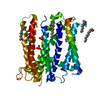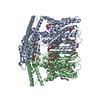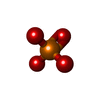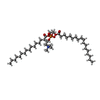+ Open data
Open data
- Basic information
Basic information
| Entry | Database: PDB / ID: 8x5b | ||||||
|---|---|---|---|---|---|---|---|
| Title | Cryo-EM structures of human XPR1 in closed states | ||||||
 Components Components | Solute carrier family 53 member 1 | ||||||
 Keywords Keywords | TRANSPORT PROTEIN / transport | ||||||
| Function / homology |  Function and homology information Function and homology informationphosphate transmembrane transporter activity / phosphate ion transport / intracellular phosphate ion homeostasis / inositol hexakisphosphate binding / phosphate ion transmembrane transport / cellular response to phosphate starvation / efflux transmembrane transporter activity / response to virus / virus receptor activity / Golgi apparatus ...phosphate transmembrane transporter activity / phosphate ion transport / intracellular phosphate ion homeostasis / inositol hexakisphosphate binding / phosphate ion transmembrane transport / cellular response to phosphate starvation / efflux transmembrane transporter activity / response to virus / virus receptor activity / Golgi apparatus / plasma membrane / cytoplasm Similarity search - Function | ||||||
| Biological species |  Homo sapiens (human) Homo sapiens (human) | ||||||
| Method | ELECTRON MICROSCOPY / single particle reconstruction / cryo EM / Resolution: 2.84 Å | ||||||
 Authors Authors | Jiang, D.H. / Yan, R. | ||||||
| Funding support |  China, 1items China, 1items
| ||||||
 Citation Citation |  Journal: Nature / Year: 2024 Journal: Nature / Year: 2024Title: Human XPR1 structures reveal phosphate export mechanism. Authors: Rui Yan / Huiwen Chen / Chuanyu Liu / Jun Zhao / Di Wu / Juquan Jiang / Jianke Gong / Daohua Jiang /  Abstract: Inorganic phosphate (Pi) is a fundamental macronutrient for all living organisms, the homeostasis of which is critical for numerous biological activities. As the only known human Pi exporter to date, ...Inorganic phosphate (Pi) is a fundamental macronutrient for all living organisms, the homeostasis of which is critical for numerous biological activities. As the only known human Pi exporter to date, XPR1 has an indispensable role in cellular Pi homeostasis. Dysfunction of XPR1 is associated with neurodegenerative disease. However, the mechanisms underpinning XPR1-mediated Pi efflux and regulation by the intracellular inositol polyphosphate (InsPP) sensor SPX domain remain poorly understood. Here we present cryo-electron microscopy structures of human XPR1 in Pi-bound closed, open and InsP-bound forms, revealing the structural basis for XPR1 gating and regulation by InsPPs. XPR1 consists of an N-terminal SPX domain, a dimer-formation core domain and a Pi transport domain. Within the transport domain, three basic clusters are responsible for Pi binding and transport, and a conserved W573 acts as a molecular switch for gating. In addition, the SPX domain binds to InsP and facilitates Pi efflux by liberating the C-terminal loop that limits Pi entry. This study provides a conceptual framework for the mechanistic understanding of Pi homeostasis by XPR1 homologues in fungi, plants and animals. | ||||||
| History |
|
- Structure visualization
Structure visualization
| Structure viewer | Molecule:  Molmil Molmil Jmol/JSmol Jmol/JSmol |
|---|
- Downloads & links
Downloads & links
- Download
Download
| PDBx/mmCIF format |  8x5b.cif.gz 8x5b.cif.gz | 186.6 KB | Display |  PDBx/mmCIF format PDBx/mmCIF format |
|---|---|---|---|---|
| PDB format |  pdb8x5b.ent.gz pdb8x5b.ent.gz | 144.4 KB | Display |  PDB format PDB format |
| PDBx/mmJSON format |  8x5b.json.gz 8x5b.json.gz | Tree view |  PDBx/mmJSON format PDBx/mmJSON format | |
| Others |  Other downloads Other downloads |
-Validation report
| Summary document |  8x5b_validation.pdf.gz 8x5b_validation.pdf.gz | 1.9 MB | Display |  wwPDB validaton report wwPDB validaton report |
|---|---|---|---|---|
| Full document |  8x5b_full_validation.pdf.gz 8x5b_full_validation.pdf.gz | 1.9 MB | Display | |
| Data in XML |  8x5b_validation.xml.gz 8x5b_validation.xml.gz | 43.2 KB | Display | |
| Data in CIF |  8x5b_validation.cif.gz 8x5b_validation.cif.gz | 58.4 KB | Display | |
| Arichive directory |  https://data.pdbj.org/pub/pdb/validation_reports/x5/8x5b https://data.pdbj.org/pub/pdb/validation_reports/x5/8x5b ftp://data.pdbj.org/pub/pdb/validation_reports/x5/8x5b ftp://data.pdbj.org/pub/pdb/validation_reports/x5/8x5b | HTTPS FTP |
-Related structure data
| Related structure data |  38065MC  8x5eC  8x5fC M: map data used to model this data C: citing same article ( |
|---|---|
| Similar structure data | Similarity search - Function & homology  F&H Search F&H Search |
- Links
Links
- Assembly
Assembly
| Deposited unit | 
|
|---|---|
| 1 |
|
- Components
Components
| #1: Protein | Mass: 54831.422 Da / Num. of mol.: 2 Source method: isolated from a genetically manipulated source Source: (gene. exp.)  Homo sapiens (human) / Gene: XPR1 / Cell line (production host): HEK293 / Production host: Homo sapiens (human) / Gene: XPR1 / Cell line (production host): HEK293 / Production host:  Homo sapiens (human) / References: UniProt: Q9UBH6 Homo sapiens (human) / References: UniProt: Q9UBH6#2: Chemical | ChemComp-PO4 / #3: Chemical | ChemComp-POV / ( #4: Chemical | #5: Water | ChemComp-HOH / | Has ligand of interest | Y | Has protein modification | N | |
|---|
-Experimental details
-Experiment
| Experiment | Method: ELECTRON MICROSCOPY |
|---|---|
| EM experiment | Aggregation state: PARTICLE / 3D reconstruction method: single particle reconstruction |
- Sample preparation
Sample preparation
| Component | Name: transport / Type: COMPLEX / Entity ID: #1 / Source: RECOMBINANT |
|---|---|
| Source (natural) | Organism:  Homo sapiens (human) Homo sapiens (human) |
| Source (recombinant) | Organism:  Homo sapiens (human) Homo sapiens (human) |
| Buffer solution | pH: 7.5 |
| Specimen | Embedding applied: NO / Shadowing applied: NO / Staining applied: NO / Vitrification applied: YES |
| Vitrification | Cryogen name: ETHANE |
- Electron microscopy imaging
Electron microscopy imaging
| Experimental equipment |  Model: Titan Krios / Image courtesy: FEI Company |
|---|---|
| Microscopy | Model: FEI TITAN KRIOS |
| Electron gun | Electron source:  FIELD EMISSION GUN / Accelerating voltage: 300 kV / Illumination mode: FLOOD BEAM FIELD EMISSION GUN / Accelerating voltage: 300 kV / Illumination mode: FLOOD BEAM |
| Electron lens | Mode: BRIGHT FIELD / Nominal defocus max: 2000 nm / Nominal defocus min: 1000 nm |
| Image recording | Electron dose: 60 e/Å2 / Film or detector model: GATAN K3 BIOQUANTUM (6k x 4k) |
- Processing
Processing
| CTF correction | Type: PHASE FLIPPING AND AMPLITUDE CORRECTION |
|---|---|
| 3D reconstruction | Resolution: 2.84 Å / Resolution method: FSC 0.143 CUT-OFF / Num. of particles: 253874 / Symmetry type: POINT |
 Movie
Movie Controller
Controller





 PDBj
PDBj












